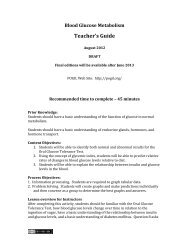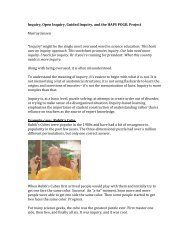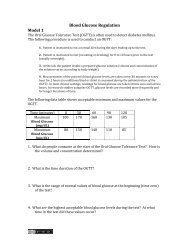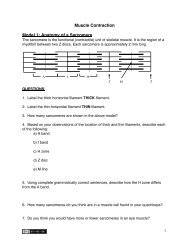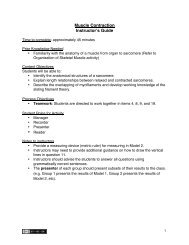Blood Glucose Metabolism Model #1:The Oral Glucose Tolerance ...
Blood Glucose Metabolism Model #1:The Oral Glucose Tolerance ...
Blood Glucose Metabolism Model #1:The Oral Glucose Tolerance ...
You also want an ePaper? Increase the reach of your titles
YUMPU automatically turns print PDFs into web optimized ePapers that Google loves.
<strong>Blood</strong> <strong>Glucose</strong> <strong>Metabolism</strong><br />
<strong>Model</strong> <strong>#1</strong>:<strong>The</strong> <strong>Oral</strong> <strong>Glucose</strong> <strong>Tolerance</strong> Test (OGTT)<br />
<strong>The</strong> <strong>Oral</strong> <strong>Glucose</strong> <strong>Tolerance</strong> Test is often used to detect diabetes mellitus. <strong>The</strong><br />
following procedure is used to conduct an OGTT:<br />
• Patient is instructed to eat a normal diet during the days leading up to the<br />
test.<br />
• Patient is instructed to fast (no eating or drinking) for 8 to 10 hours prior to<br />
the test (usually overnight).<br />
• At the lab, the patient drinks a prepared glucose solution (the volume and<br />
concentration of the solution varies according to the patient’s body<br />
weight).<br />
• Measurements of the patient’s blood glucose levels are taken every 30<br />
minutes or every hour for 2 hours (no additional food or drink is consumed<br />
during the administration of the OGTT). In most clinical settings, readings<br />
for blood glucose are taken at time zero and at two hours. In research<br />
studies using the OGTT, glucose levels are recorded more frequently and<br />
for longer durations of time.<br />
<strong>The</strong> following data table shows acceptable minimum and maximum values for the<br />
OGTT.<br />
Time (minutes) 0 30 60 90 120<br />
Maximum<br />
<strong>Blood</strong> <strong>Glucose</strong> 100 170 160 130 105<br />
(mg/dL)<br />
Minumum<br />
<strong>Blood</strong> <strong>Glucose</strong><br />
(mg/dL)<br />
80 150 140 110 85<br />
QUESTIONS:<br />
1. What do people consume at the start of the <strong>Oral</strong> <strong>Glucose</strong> <strong>Tolerance</strong> Test?<br />
How is the volume and concentration determined?<br />
2. What is the time duration of the OGTT?<br />
3. What is the range of normal values of blood glucose at the beginning (time<br />
zero) of the test?<br />
1
4. What are the highest acceptable blood glucose levels during the test? At what<br />
time in the test do these values occur?<br />
5. What is the range of normal values of blood glucose at the end of the OGTT?<br />
6. Two individuals (Maria and Laura) both complain to their doctor of frequent<br />
thirst and frequent urination. Maria has the additional symptom of blurry vision<br />
and a “tingling sensation” in her fingers and toes. <strong>The</strong> doctor suspects diabetes<br />
mellitus, a disease in which blood glucose metabolism does not stay within<br />
normal ranges. <strong>The</strong> doctor orders both to undergo an <strong>Oral</strong> <strong>Glucose</strong> <strong>Tolerance</strong><br />
Test to test this prediction. Below are the results of the OGTT.<br />
Measurements recorded during OGTT<br />
Time (minutes) 0 30 60 90 120<br />
Maria:<br />
<strong>Blood</strong> <strong>Glucose</strong> (mg/dL)<br />
Laura:<br />
<strong>Blood</strong> <strong>Glucose</strong> (mg/dL)<br />
90 140 150 135 110<br />
110 170 220 270 300<br />
a) Which individual is more suspect of having diabetes mellitus?<br />
b) Justify your answer comparing each person’s OGTT data to data found<br />
in <strong>Model</strong> 1.<br />
2
<strong>Model</strong> #2: <strong>Blood</strong> <strong>Glucose</strong> and <strong>Blood</strong> Insulin Levels<br />
Insulin is a protein hormone that is secreted into the blood by the pancreas.<br />
Clinicians rarely measure insulin levels, but the procedure is regularly done in<br />
research labs studying diabetes.<br />
<strong>The</strong> following data show blood insulin levels that correspond to the blood glucose<br />
levels in the OGTT used in <strong>Model</strong> 1.<br />
Measurements recorded during OGTT<br />
Time (minutes) 0 30 60 90 120<br />
Maria<br />
<strong>Blood</strong> <strong>Glucose</strong> (mg/dL)<br />
Maria<br />
<strong>Blood</strong> Insulin (pmol / L)<br />
Laura<br />
<strong>Blood</strong> <strong>Glucose</strong> (mg/dL)<br />
Laura<br />
<strong>Blood</strong> Insulin (pmol / L)<br />
90 140 150 135 110<br />
45 140 200 220 150<br />
110 170 220 270 300<br />
25 60 80 85 90<br />
QUESTIONS:<br />
7. What units are used to measure blood glucose? What units are used to<br />
measure blood insulin?<br />
8. On your own, draw two graphs-- one showing Maria’s glucose and insulin<br />
levels vs. time, and the second showing Laura’s glucose and insulin levels vs.<br />
time. After all individuals have completed drawing graphs, compare them with<br />
your group members. (Use a separate piece of paper if you choose)<br />
3
9. Which individual above (Maria or Laura) had the greater pancreatic response<br />
to the OGTT? How do you know?<br />
10. On your own, write a grammatically correct sentence describing the<br />
relationship between blood glucose and blood insulin levels. After each individual<br />
is finished, compare sentences and, as a group, decide on the most accurate<br />
sentence.<br />
11. Diabetics are often required to monitor their blood glucose levels to determine<br />
if/when they require a shot of insulin. Under what conditions should diabetic<br />
individuals give themselves a shot of insulin?<br />
4
<strong>Model</strong> 3: Glycemic index and changes in blood glucose<br />
Three college students (Carter, Linden, and Miriam) have their blood glucose<br />
levels measured for six hours. All three recorded what they ate for breakfast at<br />
7:30 am, but did not record any other intake of food.<br />
Carter’s Breakfast: Orange juice, high fiber regular oatmeal, and a<br />
banana.<br />
Linden’s breakfast: Sugar soda pop, Chocolate Frosted Sugar bombs, and<br />
two cups of coffee (with sugar).<br />
Miriam’s breakfast: Bacon, eggs, and two cups of black coffee.<br />
Student <strong>Blood</strong> <strong>Glucose</strong> Levels<br />
Time of Day 7 AM 8 AM 9AM 10 AM 11 AM Noon 1 PM<br />
Carter<br />
<strong>Blood</strong> <strong>Glucose</strong> 70 140 140 80 80 80 115<br />
(mg/dL)<br />
Linden<br />
<strong>Blood</strong> <strong>Glucose</strong> 70 170 55 170 55 160 55<br />
(mg/dL)<br />
Miriam<br />
<strong>Blood</strong> <strong>Glucose</strong><br />
(mg/dL)<br />
70 80 80 80 70 70 90<br />
QUESTIONS:<br />
12. Construct one graph that documents how each student’s blood glucose<br />
levels changed over the time period shown. (You may choose to use a separate<br />
piece of paper)<br />
5
13. How many times do you think each person ate during the 6-hour span? How<br />
do you know?<br />
14. What types of foods are associated with the most rapid changes in blood<br />
glucose levels?<br />
15: Glycemic Index (GI) is a numeric scale (ranging from 1 to 100) that serves as<br />
an indicator of how rapidly a food causes an increase in blood glucose levels.<br />
Carbohydrates that cause a rapid increase in blood glucose have high numbers,<br />
whereas carbohydrates that cause a gradual increase in blood glucose have<br />
lower numbers.<br />
a) Using the term “glycemic index,” describe Carter, Linden, and Miriam’s<br />
breakfasts.<br />
b) Which breakfast had the highest glycemic index?<br />
c) Which breakfast had the lowest glycemic index?<br />
16. Using the term “glycemic index,” write one or two sentences that describe<br />
the components of a healthy breakfast; one that would not cause a rapid change<br />
in blood glucose.<br />
6
CHALLENGE QUESTIONS:<br />
17. It is sometimes very dangerous to give someone a shot of insulin. Under<br />
what conditions should insulin never be administered?<br />
18. Explain how a disease of the pancreas might cause problems with glucose<br />
metabolism:<br />
19. Using your knowledge of medical terminology, define the term<br />
hyperinsulinemic hypoglycemia. What might cause this condition?<br />
20. Many people have preconceptions about diabetes mellitus. Not all of them<br />
are correct. As a group, brainstorm what you think you know about diabetes<br />
mellitus. For example, what do you think causes diabetes mellitus? What are the<br />
long-term effects of diabetes? Can diabetes kill you? If so, what is the COD<br />
(Cause of Death)?<br />
7




